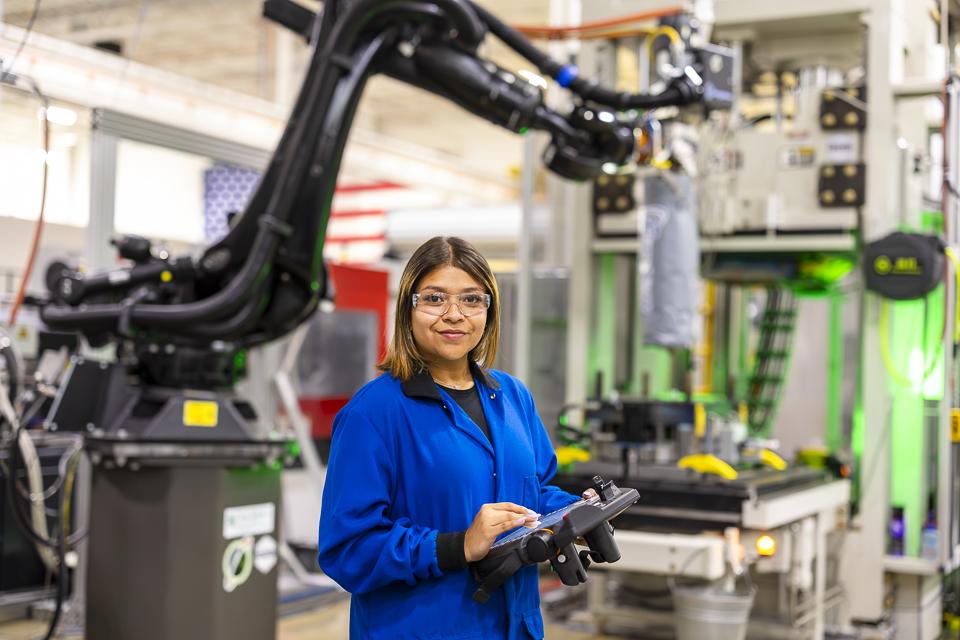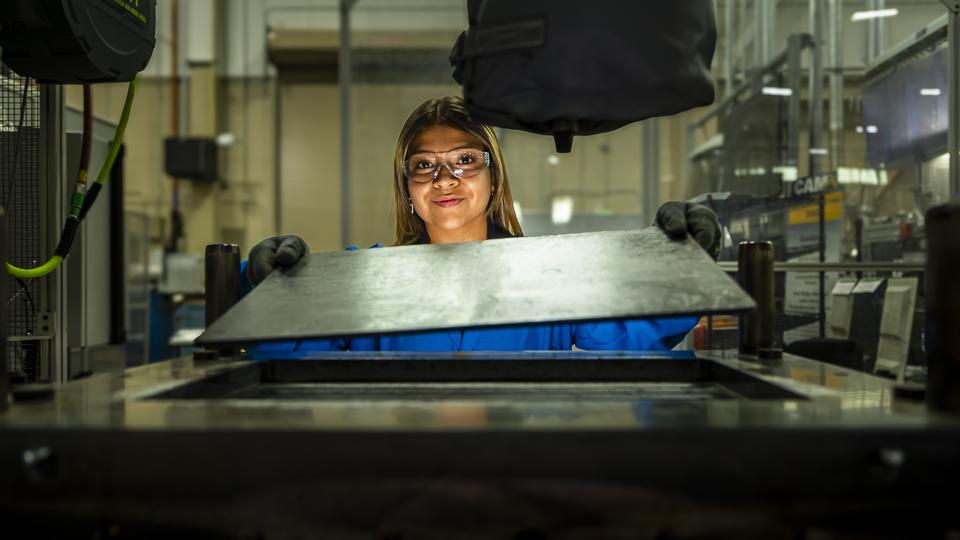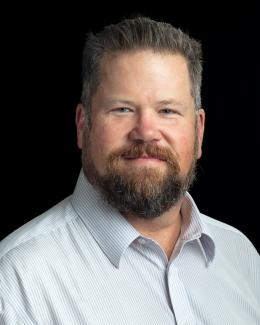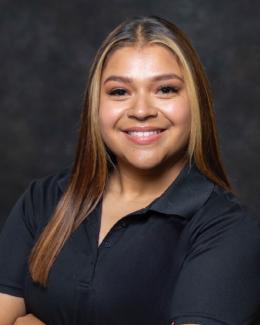
Raised in Texas’ Rio Grande Valley by hardworking parents who were not given the opportunity to obtain any type of higher degree, Brittany Rodriguez never imagined she would pursue a science career at a Department of Energy national laboratory. However, after some encouraging words from her mother, input from key mentors at the University of Texas Rio Grande Valley, or UTRGV, and a lot of hard work, Rodriguez landed at DOE’s Manufacturing Demonstration Facility, or MDF, at Oak Ridge National Laboratory.
Now that she’s blazed this trail, she’s determined to help others follow it.
“I love going back and speaking at UTRGV. I was hired as a direct result of the CA2REERS Consortium program; it opened so many doors that I never even knew existed. It’s never too late to take advantage of these chances to give back and encourage others to pursue STEM careers,” Rodriguez said.
An early-career manufacturing engineer and technical staff member at the MDF, Rodriguez focuses her research on an array of new and emerging manufacturing techniques and materials. The MDF, supported by DOE’s Advanced Materials and Manufacturing Technologies Office, is a nationwide consortium of collaborators working with ORNL to innovate, inspire and catalyze the transformation of U.S. manufacturing.
Rodriguez thrives at the MDF, a multiple R&D 100 Award-winning, advanced research and development facility. Her position as a technical professional occupies what she calls “the perfect middle ground” between scientists and technicians, where she is free to experiment, combining applied science with practical input. Today, Rodriguez and her colleagues are exploring the possibilities of advanced manufacturing applications. Improving and expanding upon existing technologies and systems in collaboration with ORNL’s many industry partners, they innovate by pursuing their own materials-based concepts. At the MDF, these materials are often composites.

Composites, or fibrous materials comprised of two or more other materials that help reinforce the resulting item, are used widely in manufacturing. Collecting data resulting from their many novel experiments in the automotive, aerospace and power-generation sectors, MDF researchers develop new technologies and scientific breakthroughs that can help manufacture better composite parts more efficiently while using less energy. These efforts encompass everything from using 3D printing to create a fully recyclable home, to designing, fabricating and testing housings for electric vehicle batteries.
A career in STEM wasn’t always part of her plan, but like her parents, Rodriguez was used to working hard. Living on her own for the first time while working on a bachelor’s degree in business at UTRGV, she worked three (and sometimes four) jobs – in addition to her academic course load.
Rodriguez was encouraged by her mother, who works in the university’s manufacturing department and had noted her degreed co-workers’ steady progress in the field. Despite her daughter’s early decision to major in business, she encouraged Rodriguez to take an introductory engineering course in manufacturing at UTRGV, saying “I can see you doing this.” Rodriguez’s father was initially dismayed by her decision but soon came around, admiring her tenacious work ethic.
As Rodriguez approached the end of her first engineering course, she was further encouraged by a powerfully inspiring professor. Edna Orozco-Leonhardt, is a Hispanic woman in a STEM leadership position – something still rare among the broader scientific community. Orozco-Leonhardt would soon become an influential role model. Like Rodriguez's mother, she recognized Rodriguez's natural abilities and passion for engineering, encouraging her to deepen her interest in the field. Serving as a mentor who supported Rodriguez “academically, emotionally, and personally,” Orozco-Leonhardt continues to be a trusted influence in Rodriguez's life today.
After developing an initial interest in engineering, an opportune moment presented itself when Rodriguez was introduced to the I-Dream 4D Consortium Internship by Jianzhi Li, a mentor at UTRGV. Li played a pivotal role in guiding Rodriguez to discern viable career pathways. The internship, which Rodriguez called an invaluable pipeline of communication and opportunities, provides summer STEM research appointments via partnered universities, manufacturers and laboratories, including active program partners like UTRGV and ORNL. Li, director of the careers consortium at UTRGV, suggested that Rodriguez apply specifically for the UTRGV internship at ORNL, which landed her in the MDF and led to two consecutive extensions.
According to Rodriguez, to extend their impact, the organizations that help create and nurture programs like I-Dream 4D must continue to take even bigger steps to invest more into the marketing and advertising of the internships they facilitate. She is certain that as they do, they will reach even more students who will otherwise be unaware of these opportunities. “These types of opportunities are huge – especially for minority-serving institutions,” she said.
Following her internship, Rodriguez was offered a full-time position at ORNL. Her project workload more than doubled upon her return, but she remains thrilled to continue her work at the MDF as a full-time technical staff researcher. In an environment with open lines of collaborative communication and respect for all opinions, she said she never felt like “just an intern” – even when she was.
One key facet of her work that motivates Rodriguez is its ongoing focus on lessening environmental impact by striving to make high-rate, low-cost manufacturing of composites more efficient and less energy dependent. A circular economic model – where materials are used, recycled, repurposed or biodegraded – is one that the MDF actively supports and an approach it encourages with its many industry partners.
Studying composites’ microstructures and mechanical properties, the efforts of Rodriguez and her fellow researchers are also helping the U.S. reach national carbon goals. Together, they hope to revitalize domestic manufacturing and restore outsourced careers, while helping advance national security, economic and clean energy priorities.
Rodriguez’s experiments use high-tech machinery and robotics systems to literally weave together disparate materials, increasing their strength and tolerance while often decreasing their overall weight. Meanwhile, these experiments are being tested for unique capabilities such as thermal and electrical conductivity, flammability and heat resistance. She also learns and uses advanced software designed specifically for the modeling and testing required for these experiments.
Of the many manufacturing materials and techniques she experiments with, “I like seeing the story,” she said. “How they’re made, how they’re injected, extruded, compressed and how they work together. Seeing the entire story of theoretical…to experiment…to real-life applications is nice in terms of understanding what composites can do. We can teach others and build from our findings, establishing baselines and growing from there.”
Eager to extend a helping hand to encourage aspiring students along the way, as others have done for her, Rodriguez often returns to UTRGV, contributing to informative panels of previous interns and reflecting on the rewarding careers that have followed.
Her advice for other young people?
“Take it one day at a time,” Rodriguez said. “Not everything’s going to go perfectly. There are outside forces, and there will be difficult days. Collaboration is huge; it’s essential to ensuring success. Learn how to find your voice, speak up with others, and don’t hold yourself back. Don’t be afraid to take new steps because there is always a steppingstone – to a new job or a different mindset.”
Regarding future plans, when asked of her own, Rodriguez cited her interest in earning a master’s degree in mechanical engineering, possibly at the University of Tennessee – Knoxville, and reiterated her commitment to the value of collaboration. “I’d like to stay here. There are endless opportunities and there is so much to learn. My colleagues and mentors are such an asset to learning, and ORNL is just a great place to work,” she said.
UT-Battelle manages ORNL for the Department of Energy’s Office of Science, the single largest supporter of basic research in the physical sciences in the United States. The Office of Science is working to address some of the most pressing challenges of our time. For more information, please visit https://energy.gov/science. – Chris Driver



